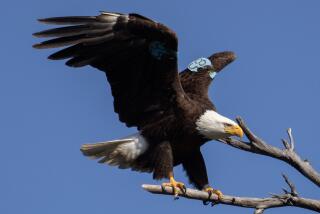Clipboard : BREEDING BIRD: DARK--EYED JUNCO (Junco hyemalis)
- Share via
Description: Species resembles sparrows in shape. Males are gray overall, females are brownish-gray and juveniles are streaked. There is a predominant white belly and outer tail feathers with a whitish bill. Males have dark hood; females and immatures are duller. Length: 5 1/2 to 6 3/4 inches. Habitat: Roadsides, brush, undergrowth; patronizes feeders. Diet: Variety of seeds and insects including some spiders; nestlings feed entirely on partially-regurgitated insects. Displays: Courting pair hop together with wings drooped, tail fanned showing white outer feathers; from a low perch the male spreads drooping wings and tail, then sings softly. Nest: Coarse grass, moss, rootlets, twigs lined with fine materials built in shallow depression. Rarely nests in trees, shrubs or buildings. Eggs: Pale bluish-white marked with reddish-browns, often wreathed. Length: 0.8 inches. Call: In-flight twittering; also, sharp dit or smack notes. Song is a loose musical trilling of a single pitch. Notes: In adults, white outer tail feathers flash conspicuously in flight. Rapid tarsal development enables nestlings to run from nest if threatened before they are able to fly. Breeding bird atlas: To report bird breeding activity in your neighborhood, or to get information on the breeding bird atlas, call Sea and Sage Audubon Society members Sylvia Gallagher, (714) 962-8990, or Nancy Kenyon, (714) 786-3160. Note: Map is divided into 5-kilometer squares so that Audubon Society volunteers can more easily survey areas on a regular basis. Sources: Sea and Sage Audubon Society; “The Birder’s Handbook,” Ehrlich, Dobkin and Wheye, Fireside Books (1988); “Field Guide to the Birds of North America,” National Geographic Society (1987); “Birds of Southern California: Status and Distribution,” Garrett and Dunn, Los Angeles Audubon Society (1981). Indicates 5-kilometer-square areas where breeding activity has been confirmed.
More to Read
Sign up for Essential California
The most important California stories and recommendations in your inbox every morning.
You may occasionally receive promotional content from the Los Angeles Times.










